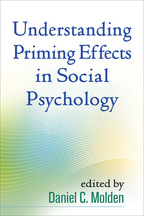Understanding Priming Effects in Social Psychology
Edited by Daniel C. Molden
“Molden has brought together the most comprehensive overview of social psychological research on priming. The chapters in this volume illuminate the history and intellectual roots of priming research, current controversies about the nature and replicability of priming effects, and the significance of theory in identifying their boundary conditions. It is a ‘must-read’ resource for everyone who wants to understand the range and the limits of priming effects on social behavior.”
—Bertram Gawronski, PhD, Department of Psychology, University of Texas at Austin
“Priming has long been a central concept in both cognitive and social psychology, yet only recently has the concept taken on different meanings with various uses. Numerous questions and issues have been debated in the literature, challenging what we thought we once knew. Molden has assembled first-rate scholars, including both advocates and skeptics in recent debates about priming, to provide balanced commentaries on a range of essential issues. This valuable volume highlights the landmarks, boundaries, and intersections encountered in charting the domain of this complex, but important and fascinating, area of inquiry.”
—David L. Hamilton, PhD, Department of Psychological and Brain Sciences, University of California, Santa Barbara
“In this timely volume from eminent psychological scientists, social priming is demonstrated to be a pervasive phenomenon that goes far beyond semantic mechanisms. The authors convincingly show that demands to place social priming on probation are based on deep ignorance about its central role in shaping human behavior.”
—Fritz Strack, PhD, Department of Psychology, University of Würzburg, Germany
Table of Contents
I. What is "Social Priming"?1. Understanding priming effects in social psychology: What is “social priming” and how does it occur?, Daniel C. Molden
2. On the other side of the mirror: Priming in cognitive and social psychology, Stéphane Doyen, Oliver Klein, Daniel Simons, & Axel Cleeremans
3. Effects of evaluation: An example of robust "social" priming, Melissa J. Ferguson & Thomas C. Mann
4. Priming is not priming is not priming, Dirk Wentura & Klaus Rothermund
5. Structured vs. unstructured regulation: On procedural mindsets and the mechanisms of priming effects, Kentaro Fujita & Yaacov Trope
II. When and How Social Priming Occurs
6. Prime numbers: Anchoring and its implications for theories of behavior priming, Ben R. Newell & David R. Shanks
7. Understanding prime-to-behavior effects: Insights from the active-self account, S. Christian Wheeler, Kenneth G. DeMarree, & Richard E. Petty
8. Replicability and models of priming: What a resources computation framework can tell us about expectations of replicability, Joseph Cesario & Kai J. Jonas
9. Situated inference and the what, who, and where of priming, Chris Loersch & B. Keith Payne
10. Priming: Constraint satisfaction and interactive competition, Tobias Schröder & Paul Thagard
III. Considering New Sources of Social Primes
11. Grounding social embodiment, Daniël Lakens
12. Priming from others' observed or simulated responses, Eliot R. Smith & Diane M. Mackie
IV. From the Past of Social Priming to Its Future
13. Evaluating behavior priming research: Three observations and a recommendation, Ap Dijksterhuis, Ad van Knippeberg, & Rob W. Holland
14. The historical origins of priming as the preparation of behavioral responses: Unconscious carry-over and contextual influences of real-world importance, John A. Bargh
15. Priming . . . Shmiming: It's about knowing when and why stimulated memory representations become active, E. Tory Higgins & Baruch Eitam
16. Understanding priming effects in social psychology: An overview and integration, Daniel C. Molden
About the Editor
Daniel C. Molden, PhD, is Associate Professor of Psychology at Northwestern University. His research examines how activating different motivational mindsets influences the ways in which people (1) gather, integrate, and interpret social information, and (2) pursue, represent, and react to social interactions. His work has been featured in publications such as the Journal of Personality and Social Psychology, the Journal of Experimental Psychology: General, Psychological Science, and American Psychologist. Dr. Molden has held fellowships from the National Institute of Child Health and Human Development and the National Institute of Mental Health, and has received funding for his research from the National Science Foundation.Contributors
John A. Bargh,Yale UniversityJoseph Cesario,Michigan State University
Axel Cleeremans,Consciousness, Cognition & Computation Group (CO3), Center for Research in Cognition & Neurosciences (CRCN), and ULB Institute for Neuroscience (UNI), Université Libre de Bruxelles
Kenneth G. DeMarree,University at Buffalo, SUNY
Ap Dijksterhuis,Radboud University Nijmegen
Stéphane Doyen,Consciousness, Cognition & Computation Group (CO3), Center for Research in Cognition & Neurosciences (CRCN), ULB Institute for Neuroscience (UNI), and Center for Research in Social and Cultural Psychology, Université Libre de Bruxelles
Baruch Eitam,University of Haifa
Melissa J. Ferguson,Cornell University
Kentaro Fujita,The Ohio State University
E. Tory Higgins,Columbia University
Rob W. Holland,Radboud University Nijmegen
Kai J. Jonas,University of Amsterdam
Olivier Klein,Center for Research in Social and Cultural Psychology, Université Libre de Bruxelles
Ad van Knippenberg,Radboud University Nijmegen
Daniël Lakens,Eindhoven University of Technology
Chris Loersch,University of Colorado
Diane M. Mackie,University of California, Santa Barbara
Thomas C. Mann,Cornell University
Daniel C. Molden,Northwestern University
Ben R. Newell,University of New South Wales, Sydney, Australia
B. Keith Payne,University of North Carolina at Chapel Hill
Richard E. Petty,Ohio State University
Klaus Rothermund,University of Jena, Germany
Tobias Schröder,University of Waterloo
David R. Shanks,University College London, London, United Kingdom
Daniel J. Simons,University of Illinois at Urbana-Champaign
Eliot R. Smith,Indiana University, Bloomington
Paul Thagard,University of Waterloo
Yaacov Trope,New York University
Dirk Wentura,Saarland University, Saarbrücken, Germany
S. Christian Wheeler,Stanford University
